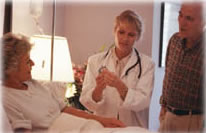


   |
SplintsSplints are sometimes used to protect wounds from further injury, or to support or immobilise limbs. If medical aid is not far away, it is better to use bulky clothing to provide support. In remote areas where help is likely to be delayed, splinting may be essential. An improvised splint can be made from a rolled newspaper, or any other firm or rigid article of suitable size. It is possible to use an uninjured leg as a splint by bandaging the injured leg to it: this method of splinting is used for a fractured thigh bone or lower leg. An injured arm can be splinted against the casualty's trunk or supported in a sling. Remember
First aid treatment
|
Online Doctor || Contact Us || Skin Disorders || Diabetes Care || Cellulite Guide || Chemotherapy ||
|
|
(c) Online-family-doctor.com All rights reserved
Disclaimer: Online-family-doctor.com is an information and educational purposes web site only. It is not intended to treat, diagnose, cure, or prevent any disease. Do not rely upon any of the information provided on this site for medical diagnosis or treatment. Please consult your primary health care provider about any personal health concerns. We will not be liable for any complications, or other medical accidents arising from the use of any information on this site.